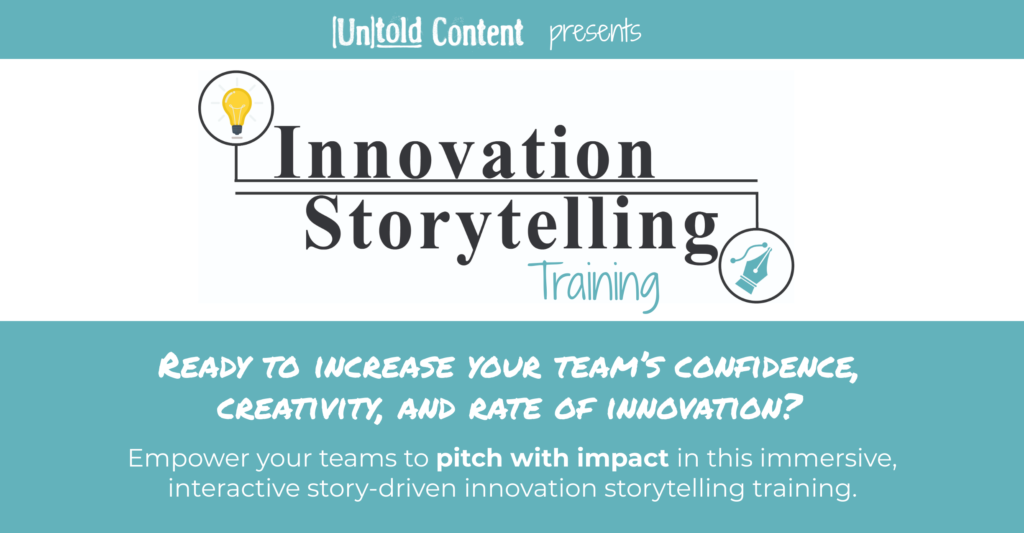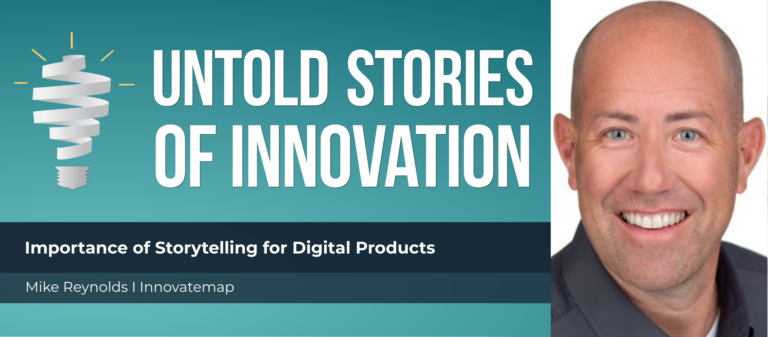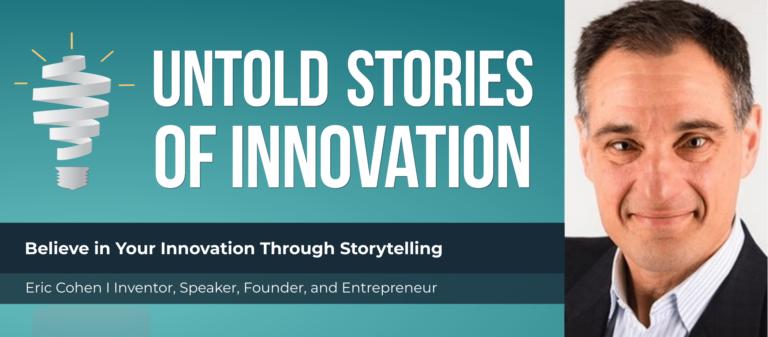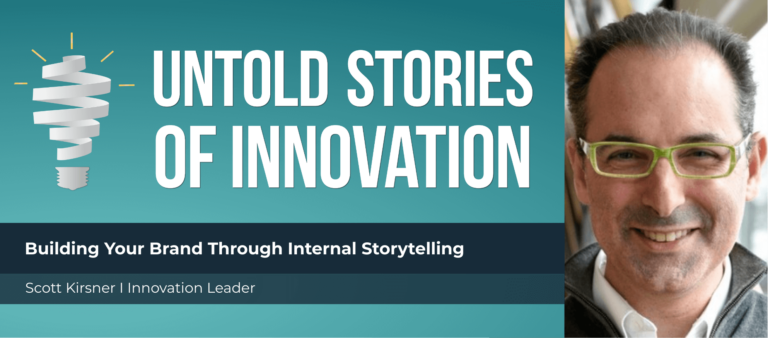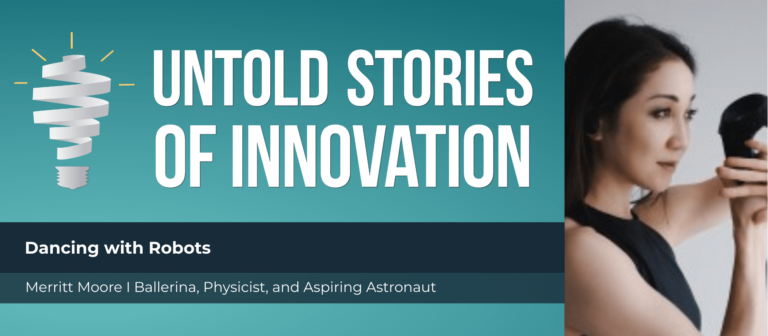Next Generation Innovation with Richard Zreik of Innovation Girls
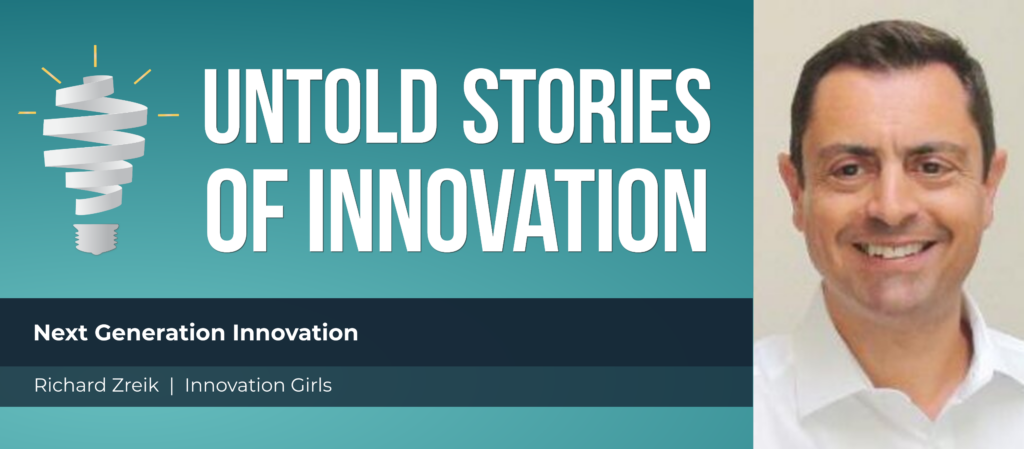
Next Generation Innovation - Untold Stories of Innovation
“If you think of innovation as 1% inspiration and 99% perspiration, we come in very strongly on that 1%. We are telling the story, a story of innovation.” —Richard Zreik, Chief Innovation Officer and Co-Founder at Innovation Girls
From today’s episode you’ll learn:
Why do stories matter to the innovation process? What values can be instilled in innovators who share stories? How do innovation leaders inspire creators to tell and share their success and failure stories?
Why do stories matter to the innovation process? What values can be instilled in innovators who share stories? How do innovation leaders inspire creators to tell and share their success and failure stories? We speak with Richard Zreik, Co-Founder and CEO of Innovation Girls, a tech startup designed to educate and empower young girls in STEM, business, and innovation. Even as attitudes change, data from ROX shows that young girls’ confidence declines between the ages of 10 to 15, causing them to drop out of sports, math, and science. And it doesn’t stop there. Only 6.6% of Fortune 500 CEOs are female, and less than 3% of venture money is going to female founders. To tackle such large societal issues, Richard discusses how thinking big in the context of tomorrow’s technology can shift the impacts of today’s innovations. Listen in for Richard’s insights into startup failures, inspiration from youthful imaginations, and the story of your favorite podcast host’s own start as an innovation girl.

Richard Zreik is a father of two young girls, an aerospace engineer, and a lifelong innovation catalyst. He has co-founded three startups in the Big Data space and has worked in retail innovation for Nissan, Tyco and Unilever. With his wife Rita, Richard co-founded Innovation Girls, a tech startup that delivers unbounded systematic business innovation through the young female mind.
untoldcontent.com/trainings/innovation-storytelling-training
TRANSCRIPT – Next Generation Innovation
This episode, Next Generation Innovation is powered by Untold Content’s innovation storytelling training. Increase buy in for your best ideas in this immersive and interactive, story-driven experience. Where your teams refine storytelling techniques for their latest projects, prototypes and pitches—and get inspired by 25 epic examples of impactful innovation stories. Learn more at https://untoldcontent.com/innovationstorytellingtraining-2/.
Katie: Welcome to Untold Stories of Innovation, where we amplify untold stories of insight, impact and innovation. Powered by Untold Content, I’m your host, Katie Trauth Taylor. Our guest today is Richard Zreik, he’s Chief Innovation Officer of a new startup called Innovation Girls, and he is also a former aerospace engineer and someone who’s been in the innovation space for a very long time. But now you are squarely seated in the founder’s position and working with your wife and daughters to build this company. Richard, I’m so grateful to have you on the podcast.
Richard: I’m so happy to be here. Thank you for hosting me.
Katie: I love how you introduce yourself on social media and when we first met. Could you tell me kind of how you lead that — you sort of call yourself a dad in innovation, is that right?
Richard: Right. Right. I am. I’m a father of two young girls and I’m a proud husband as well. And somebody who believes that innovation came from within, from within my house.
Katie: I love that. That’s incredible. So tell us about Innovation Girls and what you do and what inspired you to create this company?
Richard: Our purpose and mission is to nurture the young female self and in the process, co-create with her what’s never existed before. I’d love to take a few steps back and take you back to my personal journey of innovation.
Katie: Please. I would love that.
Richard: And then we can get to how it all happened. So, I as a young man, I went to school, Case Western Reserve University in Cleveland. And I had gotten into engineering school in the traditional way. My dad really wanted me to be an engineer. So I did mechanical and aerospace engineering and I got my master’s in aerospace engineering. When I graduated, I wanted to explore the world. I really was anxious to get out and work in different places. And so I did work in corporate America for a while. But then I decided to go work for corporate Japan, which was really a unique perspective and a shift in mindset for me as a guy who grew up in corporate America. So, I land in Dubai and I’m working for Nissan corporate, reporting to Tokyo. And one day, a few years into my gig there… By the way, I was handling — that was part of my innovation journey. I was doing a lot of work on the retail side of innovation for Nissan.
Katie: Okay.
Richard: And one day I walk into this restaurant in Dubai and I meet this girl from Cincinnati. Next thing I know, I’m in the desert of Arabia on my knees, proposing to her. That was the weirdest but it was the funniest thing and the best thing that happened to me. A few years later, I’m receiving our daughter, our first daughter, Chloe, in the American hospital in Dubai. And, Katie, something shifted in my brain. I don’t know what happened. But I went back to work a few weeks later, and I fly to Tokyo, I’m in the office with these PhD women that I’ve worked with for a good six years. It was 2007 Japan and, for the first time, I noticed that they were making coffee for the men and answering their phones. And it dawned on me a sense of shame that I did not notice this before. So I decided right there and then to pay attention, to start to pay attention.
Katie: Yes.
Richard: It was a monumental shift for me because everywhere I went in the world, I was taking notes on how women are treated, how are the laws set up about marriage and divorce, and what kind of service am I getting. I would go into a bank and repeat the same process to get the same service from a guy or girl, then I would take notes. And I have books filled with these notes. One day I want to publish a book about her. It was a fascinating journey. I would come back home and I would sit with Rita, my wife, and I would talk about these things. She’s like, I’ve been telling you this for years. I mean, I’ve done women’s studies, I’ve been working on all the women’s issues, I’m helping women. And, by the way, I’ve been working for Mars Food, too. She was working for Mars in Dubai at the time, and she was also in the innovation space for them. And she’s like, I’m about to quit my job to launch a coaching business that helps other women as well. I’m like, oh, my God. So, yeah, a few months into it, she quit her job. And it took me until our second daughter was born, Izzy. And when Izzy was born, I definitely decided right there and then that I needed to do something about it. And Rita and I — well, I quit my job at that time, and we went on this journey of lifelong learning. We started on just realizing that lifelong learning is the way to go for our kids. And we wanted to understand what it’s like. So we launched our first startup in Dubai. We failed miserably. And we learned a lot. Which was part of that journey. We launched the second one and said, okay, we’re ready to head home. So we end up in Silicon Valley, out of all places, where we don’t know anyone. We just landed there and we started on this journey of discovery. And we launched another startup there and it failed. And then we launched another one and it’s still humming today, which is awesome. Other than that, at one point we said, okay, we’re on this quest. It’s going to take a number of years. And we understand this is a long journey. But let’s go to Cincinnati. Let’s go home and raise our kids there and keep working at it. So that’s what we did. We ended up here two years ago and we incubated in Cintrifuse. And we’ve been on this journey for almost nine years now, building different models to get to Innovation Girls.
Katie: Wow. There’s so much I want to dive into. First of all, I do want you to publish those notes. If anything, at least for your daughters one day to show them that you were paying attention to those patterns and that you were aware of them. I think the more advocates that women have, especially young women, for gaining respect in the workplace, the world will be a better place. So thank you for investing that and viewing the world in that way, through the lens of another person’s, you know, through another person’s eyes. I think empathy will always play a role in innovation. And so even starting from that foundational piece of thinking empathetically about how we view each other’s world views, that’s just really powerful. So thank you for doing that. And please do publish those notes. I think that would be fantastic.
Richard: One day.
Katie: You know, going back though, to your entrepreneurial journey — and maybe we’ll have time in this episode to talk about failure and how to pivot and how to stay resilient. I think that’s such an important part of innovation, too. But I first want to ask you, it sounds like you were both in fairly enterprise-level positions, in enterprise-sized companies, rather. Tell us about that really scary decision to leave that and move into the startup world.
Richard: It was a very scary decision. It was one of those things that it’s a leap of faith almost. When you wake up at 4:00 in the morning and you wake up your spouse, you’re like, I’m doing it, that’s it, this is it. You know, it’s the oddest time, you know, the things that gnaw at you. And it’s just having that, I guess the deep sense that it’s going to work out somehow and whatever happens, we’re now — somehow we’re in it together. We have that common purpose and that will guide us somehow, that will keep us going. And at that time, you know, when you’re in the corporate world, you really don’t realize how important it is to pick up on a lot of books and literature. You barely have time to read. So there wasn’t much, I would call it, invention. Or the Italians believe that you have to have that knowledge along with the intention to get to innovation. I did not have a lot of that knowledge. The fact that I would get into a lean mode of thinking or I would be able to execute fast, you know, instead of “build it and they shall come” approach that I grew up with.
Katie: Yes.
Richard: So there was a lot to learn. But at the same time, it was just a giant leap of faith at that time. It was scary as hell.
Katie: And now you’re still working alongside your spouse, which I think — by the way, I do as well. My husband left corporate America a year ago to be our COO at Untold Content.
Richard: Congrats!
Katie: Thank you! Yes.
Richard: How is it? How is it working with a spouse?
Katie: Oh, it’s wonderful. It’s wonderful and awful at different days.
Richard: Yes.
Katie: We laugh about it. Communication — just like it in marriage outside of working together — communication is everything. But especially in your business world. Lately, what we’ve been talking about is that there’s no sense in trying to remove emotion or personal feelings from our work lives because it’s there and we care for one another. That’s just what it is. We care for everyone on our team. And I’ve always kind of approached building this company as, this is, you know, these are members of my family. I really believe as I hire people, I am very careful to hire so that I can try to get the right fit and treat them like family. So anyway, it’s communication and, yeah, and just figuring out —
Richard: Do you see some of the strategies you use in the business side that map onto the marriage side of the fence?
Katie: Oh, definitely. Definitely. I think it’s inspired us to be more creative in how we raise our children and how we run our home, you know. And right now, of course, we’re all sort of adjusting to this new normal during COVID-19. So we’re balancing our three young kids and the business together. And so we completely reworked our schedule and our lifestyle to do that. And it’s actually been — it’s been really fun. It’s been good to get a little more time with our kids and, you know, work in those parts of the day we might not normally work in but that actually are really well suited for our individual, you know, sort of periods of our day where we feel more energized or more creative.
Richard: Yes. That is wonderful.
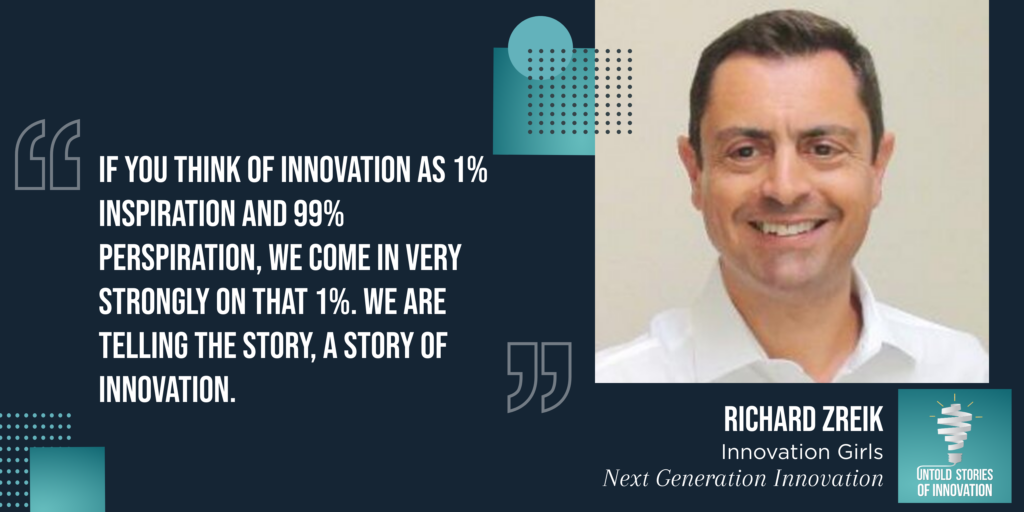
Katie: Yeah. So how about you? How about the two of you creating Innovation Girls together? When did you realize, hey, we can actually — and it sounds like you had a couple of other startups together before that, too.
Richard: It was the first time, believe it or not. The other startups were done separately. And we helped each other in terms of being there and supporting each other. But for the first time, we looked at each other, we were like, what the heck, let’s give it a try. Let’s see how it’s going to impact our marriage. And it’s been a blessing. It’s been a total blessing. It’s been — you know, it’s a journey of frustration at times, as you describe it. But as you come out of it, you’re like, oh, my God, what if we can apply this same innovative thinking to our marriage? Like, can we do the Five Day Google Sprint and use that in our marriage? What kind of questions would you come up with? How might we do what? And then we went on sprints, actually, innovation sprints, to see how we can improve on our marriage. And so there was some learning that mapped that way. And it was fun. It was a lot of fun.
Katie: That is really cool. Yeah, one of the things my husband and I did was we started a YouTube channel where we talk about our journeys with our kids. And I don’t know that we would have done that had we not gained all of this experience and comfort with content creation and, you know, just trying to kind of put yourself out there and share what’s working, what’s not working. One of our beliefs is a lot of the stuff on YouTube is really helpful and it’s positive, but sometimes it’s almost too positive, that people don’t share the realities of juggling their children and their businesses, and so —
Richard: Oh, I want to see that channel. I’ve looked at all of your websites and LinkedIn but somehow I didn’t come across the YouTube channel. So it’s my bad.
Katie: We’ve laughed about how it’s one of those things we don’t share a lot in our professional and innovation worlds because you just never know how people will react to those things, to highly more personal information. But yeah, so tell me about Innovation Girls. I think it’s such an interesting business model. It’s brilliant. So will you share it with the podcast listeners?
Richard: I would love to. Can I tell you the thinking behind it and then we get to the business model?
Katie: Yes, please.
Richard: For us, we realized that there are two paradigms that we were looking at in Silicon Valley. There was this component of moonshot thinking. Which is something we inherited from our ancestors. It was — some scientists call it mental time travel. And if it wasn’t for that mental time travel, we would not have had farming, the Magna Carta, Internet. But moonshot thinking got coined when our government — with the leadership of JFK — actually took us to the moon. And that was the beginning of a great journey. On the other hand, recently in recent history, moonshot thinking has been brought to us closer and being more democratized by the Googles of the world, who are showing us that in the digital future, we’re going to be able to have exponential thinking. And have exponential leaps with this new technology and how it’s enabling us to do that. I call it the 10X mindset. And we truly believe that if we are going to impact a social problem in today’s world, we need to think exponentially. Next Generation Innovation- We need to have that moonshot thinking because — I keep listening to your podcast. In one interview after another, we’re all admitting that the numbers have not changed over the years. We’re still at less than 4.8 percent of CEOs being female of The Fortune 500, less than 3 percent of venture money is going to female founders, and the list goes on.
Katie: Yeah.
Richard: It’s sad, but it’s still a matter of data and fact that we’re not moving the needle. And we believe wholeheartedly that we need to bring that 10X mindset into the fold. And when we were in Silicon Valley, we kept hearing, if you have a business idea and you can explain it to a 10 year old, then you have a business. Or if you can explain it to grandma and to your 10 year old, then you have a business. And we’re like, oh, my God, you know, do you realize, Katie, how sometimes you’re talking to your 5 year old and a 70 year old being like, this is golden. I mean, they have so many interesting ideas. And do you have these “aha” moments sometimes?
Katie: Oh, my goodness. They come up with ideas constantly and they think so differently than how we think, outside of all the constraints that we put on ourselves and the ways that we, you know, sometimes can be — we’re just, we’re so trained. It’s amazing how our children are so — their creativity is absolutely limitless.
Richard: Amazing. And that was the foundation for us. Thinking about how amazing they are and the way they create and they put out ideas in the world. And at one point we’re like, we’re in a corporate world. We came from the corporate world. We’re not educators. We really believe that we can bring the two together. What if we put the youth along with the innovation teams of companies and we let them go at it? But then we started to go down the path of creating models that will get us closer and closer to the high schoolers. And then we went into middle school. And then we ended up really realizing after we’ve seen our data and the data that came out of Columbus, a company called ROX, thousands of young girls were surveyed. And the conclusion is that we do have a cliff effect between fifth grade and ninth grade. Young girls go into a major cliff effect anywhere from 26 to 30 percent drop in confidence. And that drop in confidence results in them dropping out of sports, dropping out of math, dropping out of science, and the list goes on. And a lot of women carry that with them through life. And they’re working on themselves in their 40s and 50s, trying to regain that confidence in their mind, in themselves. And the whole notion of, if we are going to do something, we have to start early. That is our belief. One of our moonshot goals of getting to the big goal of solving for gender bias is to go after that cliff effect. It’s a smaller moonshot, but it’s measurable for us. It is tangible. So we’re working with young girls between the age of 10 to 15. We bring them into a whole virtual reality, virtual environment with their whole avatars and their uninhibited perspective and mindset. And we immerse them in innovative thinking and innovation mindset. We bring the latest and greatest of the TRIZ concept, the TRIZ, which is Systematic Inventive Thinking Method. So we equip them and we turn them into what you called the naive inventor. But with enough skills, with enough knowledge that’s equipped with the Bono’s work of six thinking hats and lateral thinking. And we bring in mind mapping along with that. But most importantly is, all of that is driven by them, meaning it is on demand. And if they have an interest in something, we throw it at them. They ask for it. If they have an interest in coding, you want to code to present your solution to the company. Here it is. We support you in that. And now you have a reason to learn. You have a purpose to learn. They get entrenched in a level system where they learn enough to get thrown into projects. And now they’re working in teams to solve real world business problems. So, for example, today, Fifth Third Bank hired us to look at the future of banking. And they’re excited about working with us because they’re looking at digital natives. Next Generation Innovation- These are their customers in the next 5 to 10 years. And we’re now in the trenches where we’ve got young girls working in teams imagining the future of banking. We come out of huddles every week with ideas that we storyboard. And we do exactly what you and — I’m trying to think of the Disney gentlemen.
Katie: Oh, yeah, Duncan Wardle.
Richard: Amazing guy. I love that energy.
Katie: Yes, he’s amazing. He’s so full of energy and ideas all the time.
Richard: Ideas. And one of the few people that ask questions in podcasts, which is brilliant in the way he engaged you. And that was quite unique. I love that. Duncan talked about this notion of, get rid of the PowerPoint. Screw the PowerPoint. Let’s go with storyboards and engage each other. And that’s what we do. We bring the corporate teams in with us. And there’s a “yes and” attitude, that’s an additive attitude, that comes in where we’re co-creating together. And it’s exactly in line with our purpose of “co-creating with her,” something that didn’t exist before. So we do that over a period of four to five weeks where we’re constantly meeting together, presenting each other with the ideas, meaning we present our ideas, but we bring them into the fold with our storyboards. And then we keep filtering until we get to the top two ideas that eventually get presented to the senior management of the bank, of whichever business we work with. But imagine a young girl at the age of 10 sitting at the board table with the VPs of the largest businesses in the world.
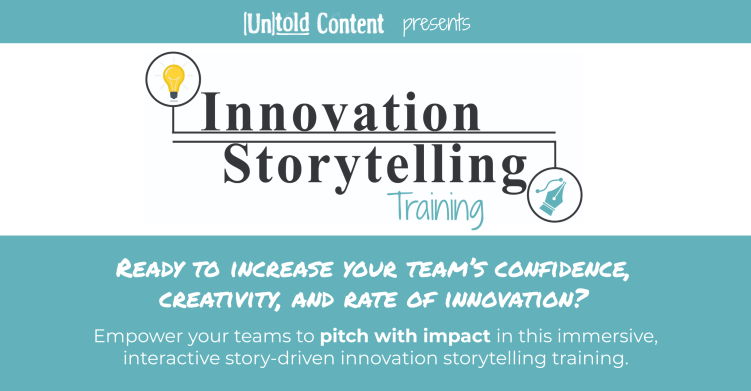
Katie: Yes, exactly. And most of that, is that happening in the virtual reality environment with real people on the other side? Or are you physically —
Richard: It is not.
Katie: OK. Yeah.
Richard: So the way we did it in Cincinnati in the first year, we tweak the model in the real world. And we did it — we went into corporate boardrooms and we had the young girls with us. And I can tell you many stories. But now we’re doing it in the virtual world where, to your point, you’ve got real people sitting behind their avatar and sitting at the board table that exactly looks like the board table at their conference room, yes.
Katie: It’s amazing. I actually — this is the first time I knew about that side of it. Is that a fairly new element to Innovation Girls?
Richard: We were planning on launching our virtual world in a year’s time. And, you know, thanks to what’s happening with this COVID-19 situation, we were squeezed into launching early and we started to, again, approach it in a very lean way. We dabbled, we learned, we failed. We finally came to a brilliant approach to it. But guess what? We’ve co-created everything about it with the young girls. They were in with us telling us we should do this, we should do that. And the girls are designing not only the space and the way we communicate the space, but they’re designing the material. So they’re involved in the co-creation of the inventive thinking method itself. So yeah, it’s exciting. It’s super exciting. I can’t tell you — when we wake up in the morning and we look at each other like, oh my God, today we’re gonna make a difference in the lives of another 50 girls. And they come with their passion and their ideas and their excitement that they’re making a difference in the world today. They don’t have to wait until their mid 20s to make a difference in the world. They’re making a difference today and they’re being heard. You know how valuable that is to have your voice heard.
Katie: OK. So I can’t wait any longer. I have to tell you a story from my past, if you can —
Richard: Please.
Katie: If you don’t mind. When I was in the fifth grade, my amazing public school teacher somehow found out about the Koffman Entrepreneur — it was called the Entrepreneurial Invention Society. And it was a competition. And we set it up across the entire fifth grade and all of us had to come up with some kind of invention and then present it. And essentially it was almost like a science fair, but for our inventions. And we had to learn — we had to write a business plan, we had to talk with people in the room as they walked past. And this was, gosh, in the 90s, I suppose. And then whoever won from the class got to go to a school, you know, the grade level and compete. And whoever won from there got to go to Kansas City. And so here I am, little 5th grade Katie, and I, with my mom, invented what is now essentially in certain fast food restaurants, you know how they have push button, you know, touchscreen menus. So that’s what I had — that’s what my mom and I had developed back then. And my dad helped me sort of make this plexiglass and wood prototype of it. And I sold it with my whole little heart and built this business plan. And I ended up in Kansas City.
Richard: That’s phenomenal.
Katie: And that is the most formative professional experience of my young life up until probably high school. But wow, what a difference that made. And my confidence.
Richard: You remember every detail.
Katie: I remember every single detail. I remember what I wore. I remember the other — you know, when I got to Kansas City, I remember where we ate. I remember what the other kids invented. I remember who won. I remember how the room smelled. It was such an important experience. And you’re delivering that. I love exploring the Innovation Girls site. All listeners, you need to check out InnovationGirls.com, and you can click on the Girls tab to look at their virtual reality worlds. But you can look at the other tabs and just see some of the girls presenting their ideas. And wow, it just reminds me, it takes me back to that. And I remember thinking at the time, this was so special and so, so unique. And I wish that every other girl in my class could have enjoyed it. But it was something that was, you know, there were limited resources, and now something like Innovation Girls is handing that over. And not only that, but you’re doing it in a collaborative way where you’re saying, actually your ideas, young women, are absolutely important and they’re valuable and they’re worth industry to fund because they deserve, you know, you deserve that. And that goes so, so much farther and expands, you know, my experience as a girl. But I can just from a personal standpoint, speak to how that absolutely set me up to believe that I could be an entrepreneur, that I could be a business person, that I could stand in front of a crowd. And that was the first time ever in my life I had, you know, been challenged to do something like that.
Richard: Thank you for sharing that story, Katie. That is a beautiful story.
Katie: I haven’t told that story in a long time.
Richard: I saw you — what I love about the story is how transformative it is.
Katie: Yes.
Richard: And how important it is for some young person to experience that and to be able to build on top of the foundation. So what we — we go the extra mile. For example, with this project, with Fifth Third Bank, we’re putting three thousand dollars as an award for fifteen young girls who are working on the project. So they split it evenly among them as team members. We go beyond that to say, you are an innovation girl. Today, you want to code for a project. We will pay you for that. Do you want to come in and become a coach, take on leadership roles. We hire you. So don’t go babysitting. Come into our platform and we would love to get you to become an inventor. And we pay you as a coach, as a leader. You lead teams and then we put you together with a master mind. So we bring in the concept of a master mind. Are you familiar with it?
Katie: I am. But tell us about it in the context of Innovation Girls and what it looks like.
Richard: So we limit the teams to a maximum of four. And each team is paired with different strengths. So each one will be looked at — she will look at the others in terms of how do they balance me? I am into coding. The other person is into finance. The third one is a great marketer and she’s pushing the envelope at the age of 13, 14 on the Web. What if we stay together for a lifetime? And we support them to be together, to stay together. And we finance them when they decide to launch a business. So the idea here is to give them everything they need to be able to say at the age of 13, 14, I have an idea and I’m gonna go with it to the world. And we’re going to encourage the hell out of that for them to be launching their entrepreneurial careers very, very early.
Katie: Yes.
Richard: So with the world today, this is what we’re talking about in terms of exponential thinking. We want them to think exponentially. We want them to change the world. But it’s going to take a 10X mindset. It’s going to take parents who say, why not, you know, let’s explore. And we have many parents that are coming along this journey saying, oh, my God, I’m seeing the transformation at home. My daughter is coming to me about this idea. She’s talking to me about my own business and she’s sharing her ideas. And I love that engagement.
Katie: I do, too. So there’s so many players that matter to the health of everything you’re doing. You know, it’s the girl, of course, is the heart and soul of this and the reason why you exist. It’s the families. So parents, younger siblings, older siblings who can all — you know, they need to be able to support this, to know about, and to invest a little tiny bit to get their daughters to get these experiences. And then there’s also the enterprise community, the business community that has so much to gain from hiring Innovation Girls and getting, you know, they’re integrating girls into their design sprints and that sort of thing. Can you tell us — you know, we’ve talked about the girls, we’ve talked about families. Can you tell us about your corporate clients and what sorts of questions you get? I would be curious to know if people are immediate believers or if there is a little bit of a gap here, an education that you have to provide to the business community to show, no, here’s why, you know, this flips the switch on all of our ways of thinking about how innovation happens.
Richard: You tackled the subject a little bit with our NASA friend, Steven. And if you think of innovation as the 1 percent inspiration and 99 percent perspiration, we come in very strongly on that 1 percent. We are telling the story, a great story of innovation. And it is a huge challenge to think of adoption of such a new paradigm. It’s a brand new paradigm. Are you telling me that with all my expertise, you’re gonna have me sitting at the table with a 12 year old, with a 13 year old? Now, that is a real paradigm shift for a lot of people. So we come to them very humbly to say, we are working on diversity. What we bring to it — we believe innovation is diversity, and we bring three different elements of diversity. We have the diversity of age, which is really key here. We have the diversity of gender, which is also super important to have that female perspective to the table. Like working with the banks, and it’s purely a male perspective. Today, we’re bringing a female perspective that we’re hoping that we can impact the future on that front. The third one is really about mentality. It’s the diversity of mentality. We have what we call this creativity of innocence. And Debono beautifully described the creativity of innocence as people who don’t know what cannot be done. They simply don’t know of any boundaries. You describe it beautifully earlier as well in your children. They have no boundaries. And that is so unique because we have the possibility of bringing fresh ideas to the fold and getting you to think outside of your rigor of thought and get you into parallel roads that can eventually be a much, much better solution to what you’re looking for.
Katie: I love the vision that it’s not just about what this is doing for the company or for the young girls, but also for the innovators who are sitting at the table next to them. How is this changing your mindset and changing the way that you think and approach the way you view the problems that your organization is trying to solve?
Richard: It’s truly — I get goose bumps every time I think about this, in terms of how the corporations are realizing today that they need to innovate and they need to speak to different constituents and not limit themselves to their own teams or even the different adult players that they’re seeing up there. But this idea of age diversity and bringing that creativity of innocence to the fold is very appealing today. So we’re excited about that. We’re super excited about that.
Katie: Can you share with us some of the innovation stories coming out? So whether that was a really awesome idea that came from one of the girls at the boardroom table or whether that’s, you know, a presentation or feedback that you heard. Really anything goes. But I would just love to hear some more kind of nuggets of what this looks like.
Richard: Yeah. So one of my favorite innovation stories is one that we worked on for Kroger. You’re familiar with Kroger, right?
Katie: Yes. Grocery store.
Richard: So Kroger has put out an open innovation call. And we saw it, we’re like, oh, my God, we’re in the early stage but what the heck. We would love to go after this open innovation challenge and solve it for them. So we applied and we went on this design thinking journey. We went into their stores. It was about tackling food waste at the time.
Katie: Yes.
Richard: And so we went into their stores and we were talking to the store managers and the employees. And you should see that the 13 young girls are sitting with pads. They’re taking notes and they’re standing in the aisles interviewing customers. And this one customer is talking to Marigold and she says, you know what, you’re talking about hunger. And this is a very deep subject and it touches me and my heart. And Marigold says, why? And what do you mean? And this customer who is standing in the aisle said, I work for Amazon. I work in their warehouse. I am the manager. And I have a good position. But soon it’s gonna be lights out. And Marigold looks at her and says, what do you mean? What is lights out? She said, we’re going to have an all robotic setup of our warehouse and there’s not going to be need for many of us to be working in that place. They’re going to turn the lights off. And that’s what they call lights out in a warehouse. It’s going to be all robots running it. And that was a moment of empathy. This was a moment for Marigold to step back and say, oh, my. This could happen to my neighbor. This could happen to my dad. I know a lot of people in our neighborhood who work for Amazon. What does that mean? And this component of empathy was built into the entire process of designing the solution. The same thing happened to Lily, she is 11 years old. She’s sitting there with the store manager, with all the other girls surrounding the store manager. And they’re asking questions. And Lily raised her hand and said, it’s 1 in 6 people in my school and 1 in 8 people in our city are going hungry at night. How is it happening? How is it here? What are the numbers like in your store? And at that exact moment the store manager put her hand on her heart. She’s like, oh, my God, let me tell you about it. And she opened up and it was another, you know, the light that shines in to the empathy aspect of understanding and building the human connection to a solution. And the answers to that question and the answers to the Amazon question never left us. And you would sit in an innovation room with an adult and you would start talking about empathy at the beginning of the journey. And then in the middle of the journey, you know, you start to forget about these things. But a young girl keeps that empathy alive throughout the project. And that was mind boggling for me in terms of how we brought it up over and over again. Every time we ideated, we’d come back to the empathy component. How are we going to be caring for the people? How are we going to be really worrying about the employees of Kroger more than anything else? And it was really beautiful.
Katie: Yes. Oh, my goodness. Thank you.
Richard: So we apply with just that little bit at the end. Among 50 companies, we’re number 50. 49 of them were experts in the field. And they came in with all their expertise and their proposals. There was a selection. You know, when the committee looked at all 50 proposals, they looked ours like, this stands out. This is weird. What is Innovation Girls? And these people went into our stores and they did a design thinking journey? Oh, my God. All the others did not do that, you know, but they bring their expertise along, which is fine. But let us hear from Innovation Girls. So we were selected among the top 10 to go and present in front of their top management. So we have the CFO there and about 7 VPs sitting around him. And all the young girls on the team, they got up on stage to introduce themselves. And one of them stood and continued with the presentation. And I can’t tell you the energy in the room when you have the CFO of a company as big as Kroger who’s handling 175 billion dollars a year. He stood there and gave them a standing ovation. Not only did we come in second and we got a big check, but he took his own personal checkbook and matched the corporate board.
Katie: Wow. Oh, my goodness. Wow, how incredible. I can’t even — again, like to take that tiny experience that I had as a young girl, and just multiply it by a million and you see what — I just, I viscerally, I can’t stop smiling as we talk about this because I just am such a strong believer that this is changing their lives and changing what’s possible to them. I talk with a lot of women in innovation about our journeys with imposter syndrome. And I hope — my hope for Innovation Girls is that every girl who’s touched by this program never has to really experience that to the same degree that our generations have. So. Wow.
Richard: We hope so. We’re trying to build it in them and give them the confidence to be true innovators. It takes time and it takes a lot of effort on everyone’s part to bring it together. So we’ve got experts coming in with us from the University of Cincinnati and the University of Steinweiss in Berlin, the university ICC, we just connected with them in Tel Aviv, IDC Heriot, they’re an Ivy League. And a lot of the thinking that’s coming from these universities is this systematic, inventive thinking that we’re honing in and looking at it from a female perspective, we’re designing it for a specific group of 10 to 15 year olds. So we’re taking an MBA program level material that’s being given to MBA students at the University of Cincinnati and University of Berlin and then the university in Israel. And we’re condensing it and working together, all three of us, to figure out ways we can storyboard that we can have it make sense and have it quickly be absorbed by these young minds.
Katie: Yes, exactly. It’s so incredible. Well, I am very inspired. I am so grateful that all of your experiences in life led you to this point to create this company. And I can’t wait to continue to see it grow and touch more lives. So thank you so much, Richard, for being on the podcast. I guess, you know, now that you’ve worked with over 100 young women in innovation, would you mind leaving us with your best advice for young women who want to be innovators and/or innovators who perhaps could learn so much from these young women, what’s your advice to the innovation community? Let’s start there. I think it’s obvious that you have so much passion and advice for the young girl. But what would you say to the innovation community to help them think differently and embrace new ways of approaching open innovation like this?
Richard: Really, I tell them that they have to think from a holistic standpoint. Most of our kids are going to make it to be about 150 to 200 years old with this new technology, the biotechnology that’s coming out in the next year or two. So they’re going to be privileged to live a long life. And if it’s all about lifelong learning and it’s all going to be about reinventing themselves every two years. And to get there, you have to really have that 10X mindset. You have to have that moonshot thinking, and this mental time travel. So just use your imagination and cherish it and something that’s quite unique and part of your genius, and take that imagination and travel with it. And create a new world for us. We need you. We need you to change this world. It desperately needs change. And if there’s anyone going to do it, it’s going to be women in America. The Dalai Lama stated it years ago. The change is going to happen. But it’s that female voice that’s needed to make it happen.
Katie: Incredible. Thank you.
Richard: Thank you.
Katie: Thank you so much for being here. Thanks for being an inspiring business owner, creator, dad. And I’m really looking forward to seeing, you know, what else happens with Innovation Girls. So where can people find you and your startup.
Richard: So they can find us on InnovationGirls.com and LinkedIn as well. We are grateful that we connected, Katie. Thank you for hosting us on this website — on this podcast.
Katie: Thank you so much, Richard. And I’ll talk to you soon.
Richard: Thank you. All the best.
Katie: Thanks for listening to this week’s episode. Be sure to follow us on social media and add your voice to the conversation. You can find us at Untold Content.
You can listen to more episodes of Untold Stories of Innovation Podcast.
*Interviews are not endorsements of individuals or businesses.

